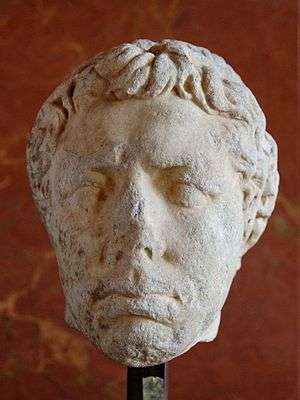AD 23
AD 23 (XXIII) was a common year starting on Friday (link will display the full calendar) of the Julian calendar. At the time, it was known as the Year of the Consulship of Pollio and Vetus (or, less frequently, year 776 Ab urbe condita). The denomination AD 23 for this year has been used since the early medieval period, when the Anno Domini calendar era became the prevalent method in Europe for naming years.
| Millennium: | 1st millennium |
|---|---|
| Centuries: | |
| Decades: | |
| Years: |
| AD 23 by topic |
|---|
| Leaders |
| Categories |
|
| Gregorian calendar | AD 23 XXIII |
| Ab urbe condita | 776 |
| Assyrian calendar | 4773 |
| Balinese saka calendar | N/A |
| Bengali calendar | −570 |
| Berber calendar | 973 |
| Buddhist calendar | 567 |
| Burmese calendar | −615 |
| Byzantine calendar | 5531–5532 |
| Chinese calendar | 壬午年 (Water Horse) 2719 or 2659 — to — 癸未年 (Water Goat) 2720 or 2660 |
| Coptic calendar | −261 – −260 |
| Discordian calendar | 1189 |
| Ethiopian calendar | 15–16 |
| Hebrew calendar | 3783–3784 |
| Hindu calendars | |
| - Vikram Samvat | 79–80 |
| - Shaka Samvat | N/A |
| - Kali Yuga | 3123–3124 |
| Holocene calendar | 10023 |
| Iranian calendar | 599 BP – 598 BP |
| Islamic calendar | 617 BH – 616 BH |
| Javanese calendar | N/A |
| Julian calendar | AD 23 XXIII |
| Korean calendar | 2356 |
| Minguo calendar | 1889 before ROC 民前1889年 |
| Nanakshahi calendar | −1445 |
| Seleucid era | 334/335 AG |
| Thai solar calendar | 565–566 |
| Tibetan calendar | 阳水马年 (male Water-Horse) 149 or −232 or −1004 — to — 阴水羊年 (female Water-Goat) 150 or −231 or −1003 |

Portrait of King Juba II (48 BC–AD 23)
Events
By place
Roman Empire
- Greek geographer Strabo publishes Geography, a work covering the world known to the Romans and Greeks at the time of Emperor Augustus – it is the only such book to survive from the ancient world.[1]
- Emperor Tiberius' son Drusus Julius Caesar dies.[2] From that point forward, he seems to lose interest in the Empire and occupies himself with the pursuit of pleasure.
- Lucius Aelius Sejanus begins to dominate the Roman Senate and Tiberius, after the death of Drusus.[3]
China
- Liu Xuan, a descendant of the Han Dynasty royal family and leader of insurgents against the Xin Dynasty, proclaims himself emperor against Wang Mang.[4]
- July – After being under siege for two months, about 19,000 insurgents under Liu Xiu defeat 450,000 of Wang Mang's troops in the Battle of Kunyang, ushering in the fall of Wang Mang's Xin Dynasty and restoration of the Han Dynasty.[5]
- October 6 — Emperor Liu Xuan's forces kill Wang Mang at the end of a three-day siege.
Births
- Pliny the Elder, Roman scientist and writer[6] (d. 79 AD)
Deaths
- September 14 – Drusus Julius Caesar, son of Emperor Tiberius[7] (b. 14 BC)
- October 6 – Wang Mang, Chinese emperor of the Xin Dynasty (b. c. 45 BC)[8]
- Juba II, king of Mauretania[9] (b. c. 50 BC)
- Liu Xin, Chinese astronomer, mathematician and politician[10] (b. c. 50 BC)
- Liu Yan, Chinese general and politician
- Servius Cornelius Lentulus Maluginensis, Roman statesman
- Wang, Chinese empress of the Xin Dynasty (b. 8 BC)
gollark: That's an example.
gollark: Why not, I don't know,```const bot = switchchat.bot()bot.plugin(plugin1)bot.addCommand("abcd", () => "Install potatOS today")```
gollark: What benefit does introducing oopy indirection bring?
gollark: WHY??!?!?!?
gollark: is an esoteric programming language.
References
- Roller, Duane W. (1998). The building program of Herod the Great. University of California Press. p. 65. ISBN 978-0-520-20934-3.
- Bunson, Matthew (2002). Encyclopedia of the Roman empire (2nd ed.). Infobase Publishing. pp. 187–188. ISBN 978-0-8160-4562-4.
- Adkins, Lesley; Adkins, Roy A. (2004). Handbook to life in ancient Rome (2nd ed.). Infobase Publishing. p. 23. ISBN 978-0-8160-5026-0.
- Giele, Enno (2006). Imperial decision-making and communication in early China: a study of Cai Yong's Duduan. Otto Harrassowitz Verlag. p. 218. ISBN 978-3-447-05334-1.
- Schram, Stuart R. (1992). Mao's road to power: revolutionary writings 1912–1949. 1. M.E. Sharpe. p. 366. ISBN 978-1-56324-457-5.
- Healy, John F. (1999). Pliny the Elder on science and technology. Oxford University Press. p. 1. ISBN 978-0-19-814687-2.
- Bowman, Alan K.; Champlin, Edward; Lintott, Andrew (1996). The Augustan Empire, 43 B.C.–A.D. 69 (2nd ed.). Cambridge University Press. p. 213. ISBN 978-0-521-26430-3.
- Clark, Anthony E. (2008). Ban Gu's history of early China. Cambria Press. p. 110. ISBN 978-1-60497-561-1.
- Rocca, Samuel (2008). Herod's Judaea: a Mediterranean state in the classical world. Mohr Siebeck. p. 58. ISBN 978-3-16-149717-9.
- Yunis, Harvey (2003). Written texts and the rise of literate culture in ancient Greece. Cambridge University Press. p. 125. ISBN 978-0-521-80930-6.
This article is issued from Wikipedia. The text is licensed under Creative Commons - Attribution - Sharealike. Additional terms may apply for the media files.